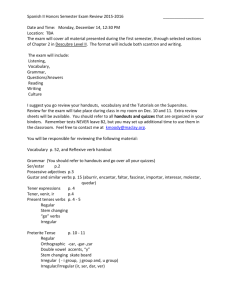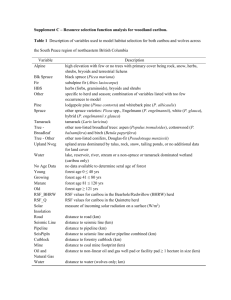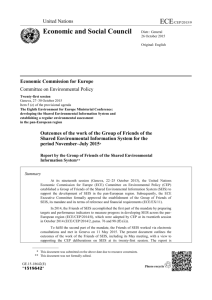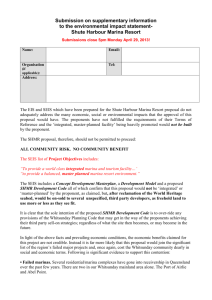eng - unece
advertisement
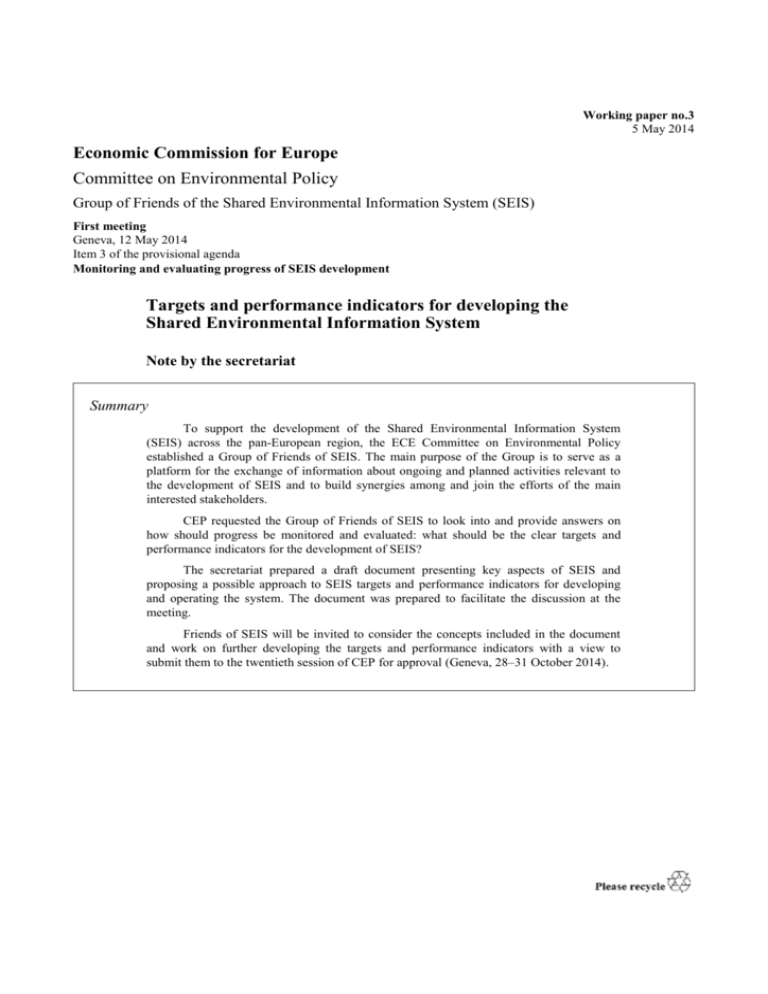
Working paper no.3 5 May 2014 Economic Commission for Europe Committee on Environmental Policy Group of Friends of the Shared Environmental Information System (SEIS) First meeting Geneva, 12 May 2014 Item 3 of the provisional agenda Monitoring and evaluating progress of SEIS development Targets and performance indicators for developing the Shared Environmental Information System Note by the secretariat Summary To support the development of the Shared Environmental Information System (SEIS) across the pan-European region, the ECE Committee on Environmental Policy established a Group of Friends of SEIS. The main purpose of the Group is to serve as a platform for the exchange of information about ongoing and planned activities relevant to the development of SEIS and to build synergies among and join the efforts of the main interested stakeholders. CEP requested the Group of Friends of SEIS to look into and provide answers on how should progress be monitored and evaluated: what should be the clear targets and performance indicators for the development of SEIS? The secretariat prepared a draft document presenting key aspects of SEIS and proposing a possible approach to SEIS targets and performance indicators for developing and operating the system. The document was prepared to facilitate the discussion at the meeting. Friends of SEIS will be invited to consider the concepts included in the document and work on further developing the targets and performance indicators with a view to submit them to the twentieth session of CEP for approval (Geneva, 28–31 October 2014). Introduction 1. The availability of integrated, relevant, high quality, timely and easily accessible environmental information provides the means for assessing environmental status and the foundation for meaningful and informed environmental governance. Conversely, a lack of such information presents a major obstacle to defining effective policies and targets for environmental conservation and sustainable use and to monitoring their effectiveness. 2. Timely, relevant, reliable and easily accessible environmental information is also essential to inform citizens about the quality of their environment so that, with full awareness, they can defend their basic right to live in a healthy and safe environment. 3. At the same time, organizing a vast array of collected environmental data and information and integrating them, where appropriate, with economic and social data is a challenging task. Even more challenging is to make these data and information available for analysis and to offer easily comprehensible, accessible and targeted recommendations to decision makers and the public or to report at the country level or internationally in accordance with legal obligations, policy commitments and mandates. 4. Recognizing the challenge, the international community in the pan-European region, facilitated the discussion and experience sharing between the various countries on the management and use of environmental information. This process led to a proposal by the European Environment Agency (EEA) to develop, initially within the European Union (EU), a Shared Environmental Information System (SEIS) – a system that, with the support of modern technologies such as the Internet, would link all the existing data and information flows relevant at the country as well as international levels. I. Background and mandate 5. The EEA proposal on the development of SEIS was agreed and launched in the EU primarily to support the reporting related to EU environmental policies and legislation. Assessing regularly the environment and developing SEIS was also considered by the ministers of environment from the pan-European region at their Seventh “Environment for Europe” (EfE) Ministerial Conference in Astana, in September 2011. Following a discussion and acknowledging the benefits of SEIS, the ministers decided to establish a regular process of environmental assessment and to develop SEIS across the region to keep the pan-European environment under review. 6. The ministers emphasized that SEIS should serve multiple policy purposes, taking into account the needs of the multilateral environmental agreements (MEAs), and that the work on SEIS and its development should include support and capacity building to countries in South-Eastern and Eastern Europe, Caucasus and Central Asia. Therefore, they invited the EEA, in cooperation with its partners, to develop an outline for SEIS activities and implement them under the auspices of the ECE Committee on Environmental Policy (CEP). 7. The progress in establishing SEIS was reviewed by CEP at its 19th session in October 2013. While CEP acknowledged the efforts made, in particular by the EEA and its partners in helping the development of SEIS in the entire ECE region, the progress made in this area was found to be rather limited. To this end, CEP decided to establish a coordination mechanism for SEIS development in the entire ECE region in the form of a Group of “Friends of SEIS” and entrusted the Group to work on two issues: (1) preparing clear targets and performance indicators to monitor and evaluate the development of SEIS 2 in the pan-European region; and (2) organizing and shaping the regular assessment process taking into consideration the benefits of SEIS. 8. Pursuant to the mandate given to the Group of Friends of SEIS, this paper was prepared to facilitate the discussion of the Group at its first meeting (Geneva, 12 May 2014) on the elaboration of targets and performance indicators for the development of SEIS in the ECE region. 9. The document is structured into two main parts: (a) Part 1 (sections II and III) on the development of SEIS introduces the key issues that should be considered in the process of an effective and efficient development of the system; and (b) Part 2 (section IV) on targets and performance indicators explores a possible approach to the formulation of targets and performance indicators. 10. The Group of “Friends of SEIS” is invited to consider the paper in general and in particular focusing on the part 2. II. Benefits of SEIS 11. The benefits from the availability of SEIS in every country of the Pan-European region could be significant for the countries as well as the international organizations and the intergovernmental bodies serviced by these organizations, e.g. the meetings of the Parties to MEAs. (a) Efficiency gain and cost savings: With SEIS the data and information will not only be available but readily accessible by their potential users. This will bring a new perspective to national reporting, including under the MEAs and should result in cost savings for the reporting processes. There also will be considerable cost savings if data and information will not need to be searched each and every time prior to carrying out an assessment. (b) Effective and meaningful governance: Availability of high quality data and information will improve policy development and decision-making processes. (c) Simplification: Readily accessible data and information will change the way of carrying out assessments, as they will be included in the national SEIS for analyses and assessments carried out at the country level as well as for general or topic related assessments carried out internationally, whether under the MEAs or various initiatives in which the countries participate. (d) Innovation: SEIS will contribute to the improvement and increased use of new technology, software or information technology platforms. (e) Informed citizens: The general public will have the opportunity to access more easily environmental data and information for their increased awareness about the environment. 3 III. Development of SEIS A. Understanding SEIS 12. SEIS is a system that should link all the existing data and information flows relevant at the country as well as international levels, and bring networks closer to each other with the support of modern technologies such as the Internet. 13. The data and information flows at the country level should allow a particular country to track the changes in its environmental status or particular environmental media and correlate these changes with the policy development and decision making processes. Data and information should be readily available for analysis and assessment to show the changes and the correlation with political decisions and further communicate them in a user-friendly and comprehensible way to policy makers and the public. 14. The international data and information flows should allow to track changes to the environment or particular environmental media sub-regionally or regionally or to inform of progress made on the agreed regional or global commitments. They should help in: (a) Preparing the assessments of the state-of-the-environment of a sub-region, regional or global assessment (e.g. pan-European assessment, or UNEP’s Global Environmental Outlook) so that changes to the environment are also seen across borders; (b) Understanding changes or progress in addressing the issues addressed by the regional MEAs and help further develop them or strengthen their implementation; and (c) Contributing to global initiatives related to sustainable development or the post-2015 development agenda, to which environmental data and information are key. 15. The national and international dimensions are not the only key aspects to be taken into account when developing SEIS. It needs to be also guided by the agreed seven SEIS principles: (a) (b) purposes; Information should be managed as close as possible to its source; Information should be collected once, and shared with others for many (c) Information should be readily available to public authorities and enable them to easily fulfil their legal reporting commitments; (d) Information should be readily accessible to end-users, primarily public authorities at all levels from local to pan-European, to enable them to assess in a timely fashion the state of the environment and the effectiveness of their policies, and to design new policy; (e) Information should also be accessible to enable end-users, both public authorities and citizens, to make comparisons at the appropriate geographical scale (e.g. countries, cities, catchments areas) and to participate meaningfully in the development and implementation of environmental policy; (f) Information should be fully available to the general public, after due consideration of the appropriate level of aggregation and subject to appropriate confidentiality constraints, and at national level in the relevant national language(s); (g) Information sharing and processing should be supported through common, free open standards. 4 B. SEIS building blocks 16. SEIS is not a technological or infrastructural development only. There are three equally important building blocks of SEIS, of which infrastructure is an important part. These three building blocks are: (1) Content; (2) Institutional Cooperation; and (3) Infrastructure. Content: concerns all the data and information necessary to understand the changes in the state-of-the-environment or in environmental media or themes (as tackled also under the MEAs). Such data and information are usually related to: air, water, soil, biodiversity, forest, waste, energy, transport, etc. They are available with various institutions at various levels and are crucial in terms of policy-making but also awareness-raising. Institutional cooperation: concerns all the holders of the relevant data and information at the various levels in the country that need to be enabled to become data and information and even assessments providers as well as users at the same time under SEIS. Therefore, this block includes issues such as: development/amendments to legal framework and data policy agreements and protocols to enable data exchange while ensuring trust building and confidence between various data providers and between them and users. Infrastructure: concerns all the e-tools and e-instruments to facilitate the sharing by providers of data and information so that it can be accessed by users including experts that would analyse the information and share it for further use. Such infrastructure comprises: information technology platforms, software, standards, methodologies and protocols for data sharing and exchange) C. SEIS - No one-size fits all approach 17. While actors involved in the development of a pan-European SEIS need to consider the national and international dimensions of SEIS as well as the SEIS principles, at the same time, the individual systems to be developed in various countries will not be and should not be identical but interoperable. The national SEIS may depend on various criteria and conditions: (a) The size and governance structure of the country would determine the number of stakeholders needed to be involved in data and information management (collection, processing, validation, and sharing); (b) The legal base or lack thereof regulating data and information management, the availability or not of a dedicated data policy; (c) The institutional structure or lack thereof for data and information management; (d) The participation in international activities and related commitments (MEAs and other international processes) or willingness and plans to join and/or participate in those the country is not a party/member yet; (e) The level of the development of information technology in the country and related to that: (i) Number and state of the art of information technology systems in use; (ii) Information technology literacy of the staff of SEIS operating institutions (information providers/managers). (f) 5 The availability of a national/local budget for monitoring and assessment: (i) to develop and maintain the system including the necessary information technology infrastructure and the capacity of staff involved in the maintenance work; (ii) to train staff of the SEIS providers/managers) on using the system. operating institutions (information (g) Developments in the e-governance field (an open data policy for data sharing, the availability of a spatial data infrastructure in the country). 18. These abovementioned criteria and conditions impact, as a minimum, the data and information in use under SEIS (Content); the number of information providers that should constitute the SEIS network and the way they manage the data and information (Institutional cooperation); as well as the complexity or level of development of the electronic infrastructure in use for the SEIS (Infrastructure). 19. It is very important that the SEIS development vision and related roadmap is built upon the criteria and conditions listed above, or – in case it was developed already – to be re-assessed against these criteria and conditions. Also, while the SEIS process can be initiated with support of donor funding, its effective and sustainable operation can be only achieved with sufficient national/local resources to maintain it. 20. At the same time, it must be stressed that the level of development of SEIS Content, Institutional cooperation and Infrastructure is not essential and the basic idea is to use what already exists. Based on the two dimensions and on principles of SEIS, the crucial points to ensure are: (a) SEIS minimum content is ensured and stored in electronic databases; (b) The minimum content is compatible (follows adopted internationally agreed standards) and interconnected virtually within and between national systems, which ensures SEIS integrity; (c) Responsibility for content (control of quality and timeliness) should be with data providers at the source, which makes SEIS decentralized while the virtual interconnectivity makes it integrated; (d) SEIS is based on the existing infrastructure, system and services available in the country or the infrastructure to be developed that can be maintained with the available resources. D. Development of SEIS vision 21. As already reasoned in this document, SEIS cannot be identical between individual countries and they can adopt their own vision for SEIS, based on criteria and conditions and the crucial points listed under the previous section: SEIS – no one-size fits all approach. 22. Countries that are at the initial steps of SEIS development, may wish to take advantage and benefit from the knowledge, experience (including lessons learned) and good practice available in countries that are more advanced in SEIS development. In this way, countries initiating the process could understand better the SEIS concept and develop their own vision for establishing effectively their national SEIS. Good practice on SEIS development, including different solutions for SEIS implementation can be found at: http://www.irceline.be http://issar.cenia.cz/issar/index.php http://www.portalu.de/ 6 http://www.geonorge.no/geonetwork/srv/eng/main.home http://www.ekoregistar.sepa.gov.rs/en http://www.arso.gov.si/ 23. Another helpful tool in SEIS development is the SEIS Cookbook prepared by EEA and available at http://enpi-seis.ew.eea.europa.eu/seis-infrastructure/seis-cookbook 24. At the same time, a milestone in helping countries to develop their SEIS vision and related roadmap as well as implement and operate the various thematic components of the system, will be a tool for self-monitoring and self-evaluation of the progress in establishing SEIS based on clear targets and performance indicators, the elaboration of which was requested by CEP. 25. Some countries, nevertheless, may require support, including to build their capacity in developing SEIS, and hence, various options may need to be considered how to efficiently provide such support to these countries. Currently a number of EU and bilateral (donor based) projects supporting SEIS development are underway across the panEuropean region (ENPI/SEIS, FLERMONECA etc.) 26. Establishing a SEIS coordination body at national level to coordinate and oversee the national SEIS developments seems useful, in particular for countries that would need further assistance in developing SEIS. IV. Targets and performance indicators A. Measuring complexity 27. A progress measurement framework for SEIS is a complex matter. Since SEIS can differ from country to country and topic to topic, the measurement framework has to offer elements and methods that can be used by every country. 28. There are countries at different stages of SEIS development, including some countries that are at a quite initial stage of this process and other countries being quite advanced, having worked on SEIS issues also under other initiatives, such as e.g. egovernance. 29. Furthermore, when SEIS is made operational, the measurement framework should also help to ensure that the system works effectively. The measurement framework should hence be suitable to address everybody’s needs, regardless the SEIS vision, or work already implemented. B. Moving towards SEIS targets 30. Due to possible differences in SEIS from country to country, it is crucial to set up general SEIS targets for which all countries should aim. These targets should meet fully the requirements for the SEIS building blocks, dimensions and principles and can be derived from linking all these requirements (see Table 1). 7 Table 1 Institutional cooperation Building block: Content Principle: to meet country and international level needs 1. Information should be managed as close as possible to its source x Infrastructure X x X x x X x 4. Information should be readily accessible to x end-users, primarily public authorities at all levels from local to pan-European, to enable them to assess in a timely fashion the state of the environment and the effectiveness of their policies, and to design new policy X x 2. Information should be collected once, and shared with others for many purposes 3. Information should be readily available to public authorities and enable them to easily fulfil their legal reporting obligations 5. Information should also be accessible to x enable end-users, both public authorities and citizens, to make comparisons at the appropriate geographical scale (e.g. countries, cities, catchments areas) and to participate meaningfully in the development and implementation of environmental policy x 6. Information should be fully available to the general public, after due consideration of the appropriate level of aggregation and subject to appropriate confidentiality constraints, and at national level in the relevant national language(s) x 7. Information sharing and processing should be supported through common, free open standards x x 31. Accordingly, the following targets for monitoring progress on SEIS are proposed per building block, which if fully met, would indicate that SEIS was developed and can be effectively operated. Content A1. Environmental datasets (to meet country and international level policy needs) are identified and agreed (anchored in national legislation), A2. Agreed requirements for units, calculation methods, etc. for indicators and underpinning datasets are described through Metadata, A3. 8 Agreed methods for preparing datasets and their aggregation, are agreed. Institutional cooperation B1. Clear protocols for intersectoral institutional cooperation for data management (collection, processing, and validation) are established, B2. Interoperability protocols for intersectoral institutional cooperation enabling timely data flow (national and international) and public sharing are established, B3. Access rights by public authorities and the public are defined Infrastructure C1. Availability of electronic databases to data managers is ensured, C2. Environmental indicators described/structured by Metadata, C3. underpinned by datasets are available online Software protocols are based on open standards. 32. Following the definition of the targets, the performance indicators should measure the advancement towards the defined targets. 33. At the same time, it should be acknowledged that there are three major phases, fairly independent, in which SEIS needs to be measured independently. These are linked with the maturity of SEIS development in the different countries, as follows in the three phases: (a) SEIS initial development (b) SEIS implementation (c) SEIS effective operation. 34. Depending on the SEIS maturity in a country, separate performance indicators should be applied for each of the phases 1 to 3 to measure progress of SEIS development. For each indicator there should be milestones defined, which would need to be addressed, as minimum, to ensure that the SEIS be developed and operated to meet the targets. A proposal for the indicators and related milestones are presented below. C. Performance indicators 1. Performance indicators for phase 1 – initial SEIS development 35. This phase is linked with the development of SEIS vision and design, and an assessment of the existing situation vis-à-vis that vision (a stock taking). With other words, a country would need to identify its gaps in the Content, Institutional cooperation and Infrastructure vis-à-vis its own vision and, hence, define what outputs it would need to elaborate under Content (A1-A3), Institutional cooperation (B1-B3) and Infrastructure (C1C3). 36. The baseline for the phase 1 is the vision and design of a particular country for its SEIS. 37. The performance indicators should measure within a set time period the completion of the stock taking exercise and the completion of outputs defining exercise for meeting the vision and design. 38. The progress should be measured by the number of specific tasks completed within a set time period and since the start of the phase under each of two indicators. The tasks need to cover, as minimum, the milestones A1-A3, B1-B3 and C1-C3 presented in Table 2. 9 39. The completion of the tasks can be verified through an availability of a report describing the work carried out and the results achieved. Table 2 Building block Indicator Content Institutional cooperation Infrastructure Performance indicator 1.1: completeness of stock taking: A1. Full knowledge of: - environmental indicators and datasets already in use B1. Full knowledge of public authorities responsibilities for collection and processing data underpinning the indicators C1. Full knowledge of use of electronic databases by data managers from public authorities - legal basis to apply the indicators and collect the data B2.Full knowledge underpinning them of: A2. Full knowledge on which indicators are clearly described by Metadata (units, calculation and validation methods) and whether the Metadata meets the internationally accepted standard - the kind of data flows taking place -legal basis for the flows (legal requirement, memorandum, ad hoc exchange) C2. Full knowledge of on-line availability of indicators and underpinning datasets, including with description through Metadata, including participation in various on-line data publishing projects (e-governance, PRTRs, etc.) B3. Full knowledge of: C3. Full knowledge - any automated data of IT solutions in use A3. Full flows (direct for data on-line understanding on the retrieve) or any sharing necessity of data password protected aggregation access - legal basis for the above Performance indicator 1.2: definition of outputs: 10 A1. Definition of a list of missing environmental indicators and datasets (those indicators produced at an ad hoc basis to be also included in the list). The existing and newly defined indicators and datasets have to meet the demand for the minimum content both with regard to country and international (e.g. B1. Definition of a list of responsibilities to be set up for collection, processing and validation of data underpinning the indicators (can include changes to existing responsibilities) [number and kind of outputs defined] B2. Definition of a C1. Elaboration of a list of indicators and their underpinning datasets for which electronic databases need to be set up or upgraded [number and kind of outputs defined] C2. Elaboration of a list of indicators and underpinning them data (including Metadata) that need Building block Indicator Content Institutional cooperation Infrastructure MEAs obligations) policy requirement. The content of various thematic components to be included in every national SEIS is defined in Annex 1) [number and kind of outputs defined] list of responsibilities to be set up for providing data (enabling new data flows, can include possible changes to existing data flows). This can also include data flows on indicators from e.g. MEAs [number and kind of outputs defined] to be available online [number and kind of outputs defined] B1. Elaboration of a list of indicators (can be also relevant for those already in use) for which Metadata needs to be developed and/or modified to meet the internationally accepted standard [number and kind of outputs defined] C3. Definition of needs for elaboration/ adoption of IT solutions for on-line sharing using open standard [number and kind of outputs defined] B3. Definition of needs for automated (one way or two ways) data flows rules to be set up including e.g. to secretariats of MEAs (direct access) [number and kind of outputs defined] A3. Elaboration of a list with rules for the application of data aggregation [number and kind of outputs defined] 40. Each country should not only define its tasks as per the milestones but also it should set up the implementation timeframe for each of these tasks. The country should then measure its progress in a quantitative way by dividing the specific tasks completed within a given time period by the total number of tasks it planned for completion within that time period. Calculation formula: P1 = Where: ∑TcomY is a sum of those tasks that were completed within the set time period ∑TtotY is the sum of all the tasks planned for the set time period 41. Further, in order to verify its progress on completion of tasks vis-à-vis all planned tasks, each country should measure it by dividing completed tasks by all planned tasks. Calculation formula: Where: 11 P2 = ∑Tcom is the sum of those tasks that were completed ∑Ttot is the sum of all the tasks 42. In addition to the assessment of progress in the quantitative way, the results achieved should be described so that countries can have better insight on the quality of work carried out. 2. Performance indicators for phase 2 – SEIS implementation 43. This phase is linked with the implementation of the individual outputs as selfdefined by each country for itself during phase 1. Each item defined for elaboration (e.g. new indicator to be elaborated, Metadata to be developed, responsibilities to be set up, electronic database to be set up, etc.) should be counted as separate outputs. Thus, the outputs of phase 1 for every country constitute its baseline for measurement under phase 2. 44. The performance indicator should measure the implementation of the outputs under Content, Institutional cooperation and Infrastructure within a set time period and since the start of the phase and cover, as minimum, the milestones (A1-A3, B1-B3 and C1-C3) on outputs, as presented in Table 3. Table 3 Building block Indicator Content Institutional cooperation Iinfrastructure Performance indicator 2.1: implementation of outputs A1. Establishment of new indicators and datasets as defined under phase 1 so that a complete set of indicators and datasets would be available. The indicators and datasets need to be anchored in the national legislation B1. Establishment of responsibilities for each of the newly established indicators and for existing ones for which clear responsibilities were not in place (as defined under phase 1), so that for each indicator there would be clear data collection and processing responsibilities, which are anchored in the legislation. [Available: Known number of single collection and processing responsibilities to be established] C1. Development of each of the electronic databases as per the list under phase 1 so that each dataset and indicator is managed through an electronic database. [Available: Known number of databases to be developed] [Available: Known number of new indicators for establishment] C2. On-line publication of indicators and underpinning datasets (including Metadata) in A2. Elaboration of accordance with the Metadata for new set rules and IT indicators and solutions as per the datasets for those list defined under existing ones where phase 1 so that all such were missing indicators and the B2. Establishment of underpinning [Available: Known number of Metadata responsibilities and datasets are available rules to share data as on-line. [Available: for elaboration] per the list elaborated Known number of under phase 1. on-line publications [Available: Known to be done] A3. Elaboration of rules/procedures for number of single flow responsibilities the application of to be established] C3. Definition of IT data aggregation solutions for on-line [Available: Known sharing using open number of rules to be 12 Building block Indicator Content Institutional cooperation Iinfrastructure developed] B3. Establishment of automated data flow rules (direct access) as per the worked out IT solutions. [Available: Known number of the direct access rules to be established] standard (xml schemas, RDF feeds for data deliveries, linking codelists, etc.). [Available: Known number of IT solutions to be made available] 45. Each country should set up a timeframe for its implementation of each specific output. The country should then measure its progress in quantitative way by dividing the completed specific outputs within a set time period by its total number of outputs planned for completion within that time period. Calculation formula: P1 = Where: ∑OcomY is the sum of those outputs that were completed within the set time period ∑OtotY is the sum of all the outputs planned for the set time period 46. Further, in order to verify the progress on completion of outputs vis-à-vis all planned outputs, the implementing country should measure it by dividing specific completed outputs by all planned outputs. Calculation formula: P2 = Where: ∑Ocom is the sum of those outputs that were completed ∑Otot is the sum of all the outputs 47. The quality progress can be verified through the descriptive report on the implementation of the outputs within a set time period. For some of the outputs, the results achieved will be visible through the information and the way this information is made available on-line. 48. The SEIS is fully developed if all the outputs are implemented, as planned. The planning can be corrected (outputs added, removed or changed) through corrective actions during the implementation process. The changes need to be included in the calculation of the quantitative progress. 3. Performance indicators for phase 3 – SEIS effective operation 49. This phase is linked with ensuring that the SEIS developed rules and procedures are maintained up- to-date and enforced to keep the system fully operational. 50. The performance indicator should measure the needs for relevant update of rules and procedure and their implementation. 51. The level of effective operation should be measured by the number of specific tasks identified for updating in the system and completed/non-completed within a set time period (include also tasks not completed in the previous time period) and number of update tasks completed since the start of the stage. They should cover, as minimum, the milestones (A1A3, B1-B3 and C1-C3) presented in Table 4. 13 Table 4 Building block Indicator Content Institutional cooperation Infrastructure Performance indicator 3.1: effective operation A1. Needs for review to indicators as per changes in the policy requirements at national or international levels B1. Needs for changes to responsibilities as per changes in the institutional framework, etc. C1. Needs for update and upgrade of databases as required A2. Needs for changes in Metadata for the reviewed indicator B2. Needs for changes to flow responsibilities as per changes to indicators, institutional framework, etc. A3. Needs for review of aggregation rules B3. Needs for as necessary changes to automated data flow rules as required (included with MEAs secretariats) C2. Needs for changes in the online publication to reflect changes under content or in IT solutions C3. Needs for implementation of a new standard 52. Each country should measure the level of effective operation by estimating how much the non-completed tasks decrease the level of effective operation considered as 100%, e.g. the country may decide that one non-completed update task decreases the effective operation by 1%, what is an expert opinion. The country should also measure the total number of update tasks implemented since the start of the stage. Calculation formula: E1 = 100% - estimated % in operation decline taking into account ( Where: Ucom are the completed update tasks Uall are all the update tasks Calculation formula: E2 = U1 +U2 + …. + Un Where: U1, U2, Un are the since the start of the stage update tasks implemented 53 The effective operation of SEIS can be then verified qualitatively through a descriptive report on implementation of the necessary update tasks. D. Performance management 54. The targets and performance indicators are intended for self-assessment by the countries, who are invited to manage the application of these indicators with the use of reporting forms proposed in Annex 2. 14 55. At the same time, since the establishment of SEIS is crucial for the wider context than the national one and since working together can accelerate any process, the individual countries should be interested in reporting to each other on progress achieved and challenges faced under the SEIS process. To this end, CEP may consider establishing an intergovernmental body or assign this task to an existing body that would serve as a platform to review the progress achieved and challenges faced, offer solutions to the challenges and report on the overall progress back to the CEP. 56. Such an intergovernmental body could be meeting annually, e.g. each spring to take stock and discuss the work carried out by countries during a preceding calendar year, i.e. a possible time period during which progress be measured. 57. Furthermore, the intergovernmental body could be given a mandate to design and provide upon availability of funding from donors hands-on assistance activities to meet the specific challenges countries may be facing in particular during the SEIS development phase. 58. The body should be opened to participation of the representatives of the MEAs intergovernmental bodies and other interested international organizations to be able to discuss emerging issues with regard to SEIS Content, Institutional cooperation and Infrastructure, 59. The body, if established, should be serviced by the ECE secretariat, whose adequate capacity should be ensured for this service. 60. The review of performance on SEIS can also be a subject of the Environmental Performance Review process for countries of South-Eastern and Eastern Europe, Caucasus and Central Asia. E. Issues for consideration 61. The following issues are proposed for consideration by the Friends of SEIS. (a) What should be the approach to measuring SEIS performance and at which level taking into account the measuring complexity under SEIS? (b) What would you like to see as relevant SEIS targets? (c) Do you believe SEIS should be assessed depending on its phase of maturity (SEIS initial development, SEIS implementation, SEIS operation)? (d) Would you think that milestones constituting minimum requirements for meeting SEIS targets should be identified? (e) What would you like to see as relevant SEIS performance indicators and how would you like to link them with SEIS targets/milestones? (f) Do you think it is beneficial to measure SEIS in quantitative and qualitative ways and why? (g) Taking into account that SEIS measurement framework should be a selfassessment tool for application by countries, would you see a need to establish an intergovernmental platform to help the countries manage SEIS? How would you like to see this platform working? Who should the platform be opened to? 15 Annex I The requirement for content on the various thematic components to be included in every national SEIS [proposal for discussion and agreement] A. Air pollution and ozone depletion Dataset as covered under the following environmental indicators (see for the specific datasets: http://www.unece.org/env/indicators.html): A1. Emissions of pollutants into the atmospheric air A2. Ambient air quality in urban areas A3. Consumption of ozone-depleting substances Other datasets required in relevant MEAs or other commitments s: …………… B. Climate change Dataset as covered under the following environmental indicators (see for the specific datasets: http://www.unece.org/env/indicators.html): B1. Air temperature B2. Atmospheric precipitation B3. Greenhouse gas emissions Other datasets required in relevant MEAs or other commitments: …………… C. Water Dataset as covered under the following environmental indicators (see for the specific datasets: http://www.unece.org/env/indicators.html): C1. Renewable freshwater resources C2. Freshwater abstraction C3. Total water use C4. Household water use per capita C5. Public water supply C6. Connection of population to public water supply C7. Water losses C8. Reuse and recycling of freshwater C9. Drinking water quality 16 C10. BOD and concentration of ammonium in rivers C11. Nutrients in freshwater C12. Nutrients in coastal seawaters C13. Concentrations of pollutants in coastal seawater and sediments (except nutrients) C14. Population connected to wastewater treatment C15. Wastewater treatment facilities C16. Polluted (non-treated) wastewaters Other datasets required in relevant MEAs or other commitments: Common indicators of Protocol on Water and Health 1: Drinking water quality – bacteriological and chemical indicators Reduction and scale of outbreaks and incidence of infectious diseases potentially related to water – incidence (number of cases) and number of outbreaks for a number of infectious diseases Access (total, urban, rural) to drinking water (not necessarily centralized) – definition of access may be chosen by a Party Access (total, urban, rural) to sanitation (not necessarily centralized (wastewater treatment)) – definition of access may be chosen by a Party Water quality – Status of surface and groundwaters – based on EU definitions for EU countries or for non-EU – Parties explain and report according to national classification Water use – Water exploitation index according to sectors – agriculture, industry, and domestic use (indirectly means reporting on annual abstraction and annual renewable freshwater resources) …………… D. Biodiversity Dataset as covered under the following environmental indicators (see for the specific datasets: http://www.unece.org/env/indicators.html): D1. Protected areas D2. Biosphere reserves and wetlands of international importance D3. Forest and other wooded land D4. Threatened and protected species D5. Trends in the number and distribution of selected species D6. Invasive alien species 1 17 For details, see table 4 in the Guidelines on the setting of targets, evaluation of progress and reporting under the Protocol on Water and Health (ECE/MP.WH/5), available at http://www.unece.org/index.php?id=11644. Other datasets required in relevant MEAs or other commitments s: …………… E. Land and soil Dataset as covered under the following environmental indicators (see for the specific datasets: http://www.unece.org/env/indicators.html): E1. Land uptake E2. Area affected by soil erosion Other datasets required in relevant MEAs or other commitments: Contamination of land and soil …………… F. Agriculture Dataset as covered under the following environmental indicators (see for the specific datasets: http://www.unece.org/env/indicators.html): F1. Irrigation F2. Fertilizer consumption F3. Gross nitrogen balance F4. Pesticide consumption Other datasets required in relevant MEAs or other commitments: …………… G. Energy Dataset as covered under the following environmental indicators (see for the specific datasets: http://www.unece.org/env/indicators.html): G1. Final energy consumption G2. Total energy consumption G3. Energy intensity G4. Renewable energy consumption G5. Final electricity consumption G6. Gross electricity production Other datasets required in relevant MEAs or other commitments: …………… H. Transport Dataset as covered under the following environmental indicators (see for the specific datasets: http://www.unece.org/env/indicators.html): 18 H1. Passenger transport demand H2. Freight transport demand H3. Composition of road motor vehicle fleet by fuel type H4. Average age of road motor vehicle fleet Other datasets required in relevant MEAs or other commitments: …………… I. Waste Dataset as covered under the following environmental indicators (see for the specific datasets: http://www.unece.org/env/indicators.html): I1. Waste generation I2. Transboundary movements of hazardous waste I3. Waste reuse and recycling I4. Final waste disposal Other datasets required in relevant MEAs or other commitments: …………… 19 Annex II Reporting forms I. Reporting form under phase 1 Building block Indicator Content: Performance indicator 1.1: completeness of stock taking: Insert the specific tasks with time frame for implementation (Y1-in first year, Y2-in second year, etc.) and mark if completed Task A1.1 in Y1: Institutional cooperation Y/N Task B1.1 in Y2: Y/N Task C1.1 in Y2: Y/N Task A1.2 in Y1: Task B1.2 in Y2: Task C2.1 in Y2: Task A2.1 in Y2: Task B2.1 in Y1: Task C2.3 in Y1: Etc. Etc. Etc. ∑totA in Y1 = [ ], ∑totAcom in Y1 = [ ] ∑totB in Y1 = [ ], ∑totBcom in Y1 = [ ] ∑totC in Y1= [ ], ∑totCcom in Y1= [ ] Progress achieved in the measured time period: P1= Progress achieved since the work started: P2 = Brief explanation on the implemented tasks: 20 Infrastructure Building block Indicator Content: Performance indicator 1.2: definition of outputs:: Insert the specific tasks with time frame for implementation (Y1-in first year, Y2-in second year, etc.) and mark if completed Task A1.1 in Y1: Institutional cooperation Y/N Task B1.1 in Y2: Y/N Task C1.1 in Y2: Y/N Task A1.2 in Y1: Task B1.2 in Y2: Task C2.1 in Y2: Task A2.1 in Y2: Task B2.1 in Y1: Task C2.3 in Y1: Etc. Etc. Etc. ∑totA in Y1 = [ ], ∑totAcom in Y1 = [ ] ∑totB in Y1 = [ ], ∑totBcom in Y1 = [ ] ∑totC in Y1= [ ], ∑totCcom in Y1= [ ] Progress achieved in the measured time period: P1= Progress achieved since the work started: P2 = Brief explanation on the implemented tasks: 21 Infrastructure II. Reporting form under phase 2 Building block Indicator Content: Performance indicator 2.1: implementation of outputs: Insert the specific outputs with time frame for implementation (Y1-in first year, Y2-in second year, etc.) and mark if completed Output A1.1 in Y1: Institutional cooperation Y/N Output B1.1 in Y2: Y/N Output C1.1 in Y2: Y/N Output A1.2 in Y1: Output B1.2 in Y2: Output C2.1 in Y2: Output A2.1 in Y2: Output B2.1 in Y1: Output C2.3 in Y1: Etc. Etc. Etc. ∑totA in Y1 = [ ], ∑totAcom in Y1 = [ ] ∑totB in Y1 = [ ], ∑totBcom in Y1 = [ ] ∑totC in Y1= [ ], ∑totCcom in Y1= [ ] Progress achieved in the measured time period: P1 = Progress achieved since the work started: P2 = Brief explanation on the implemented tasks: 22 Infrastructure III. Reporting form under phase 3 Building block Indicator Content: Institutional cooperation Performance indicator 3.1: effective operation Insert the specific tasks and mark if completed Infrastructure Task A1.1: Task B1.1: Task C1.1: Task A1.2: Task B1.2: Task C2.1: Task A2.1: Task B2.1: Task C2.3: Etc. Etc. Etc. ∑totA = [ ], ∑totAcom = [ ] ∑totB = [ ], ∑totBcom = [ ] ∑totC = [ ], ∑totCcom = [ ] Estimation of decrease in effective operation: E1 = 100% - estimated % in operation decline taking into account Number of update tasks implemented: E2 = ∑totA + ∑totB + ∑totC Brief explanation on the implemented outputs: 23

